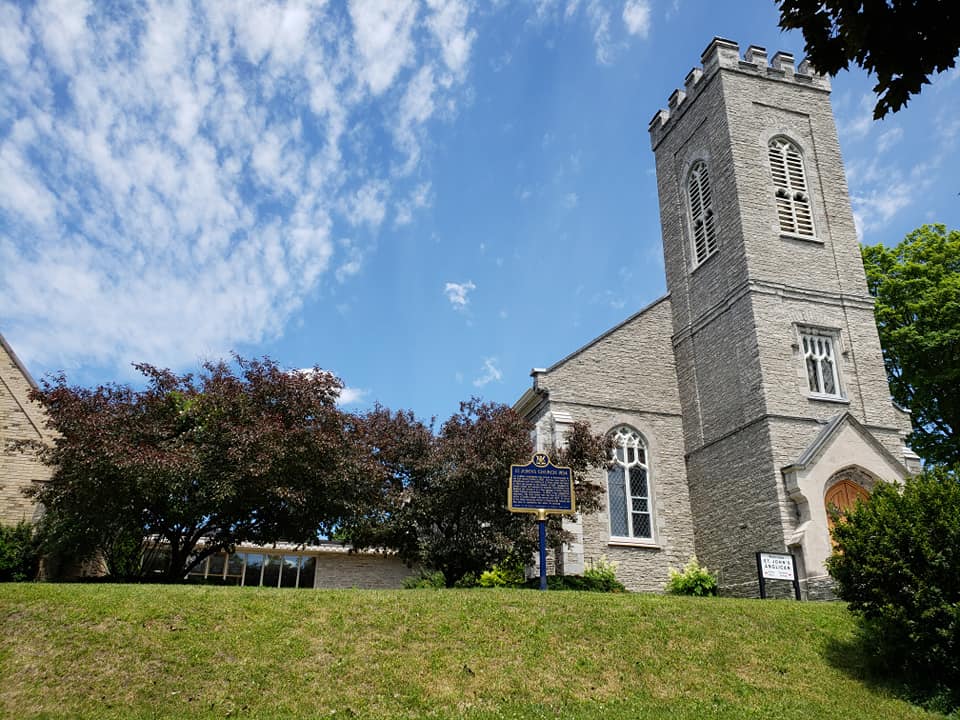A Peterborough Anglican church is allowing homeless people to camp on its lawn, in response to a protocol that prevents them from camping in public parks.
St. John The Evangelist opened up their green space to campers in the middle of May. Three tents are set up so far. The church is already heavily involved with supporting Peterborough’s homeless population: it runs the Warming Room Community Ministries program, which provides shelter and meals. But above anything else, helping out marginalized people seemed fitting for a Christian institution.
You may unsubscribe from any of our newsletters at any time.
“In the framework of Matthew 25, Jesus tells us that whatever you do, for the least of my brothers and sisters, you do also for me, and one of those things is to give shelter to the homeless,” said Rev. Canon Brad Smith, who is leading this initiative. Upon inviting homeless folks to camp on the church’s lawn, Rev. Smith sent a letter to parishioners explaining why tents will pop up at their place of worship.
“All of the actual articulated responses that I received have been overwhelmingly positive and supportive,” he said. “And to date, while I suspect that there are people who don’t agree with the decision, nobody has actually said so.”
The camping protocol, which Peterborough This Week previously reported on, was introduced last year in response to a growing number of complaints, said Dorothy Olver, manager of homelessness and addictions services with Peterborough’s social services division. The city also needed a strategy to help redirect people to other facilities.
“We wanted the opportunity to talk to people to try to connect them to services and try to support them as best we can,” she said. Her department keeps track of the city’s homelessness rate and counted 259 people without a home last year. It also helps support Peterborough’s emergency shelters.
St. John The Evangelist is in the city’s downtown core, making facilities like other shelters and city services easy to access for those who are homeless. It also prevents them from having to camp somewhere secluded, which means that social service workers can still find them and provide assistance if needed. But this visibility is also what led homeless people being asked to remove their tents from public places like Victoria Park. Under Peterborough’s “living rough camping response” protocol, people are given 10 days to leave their camps. If, after five days, they refuse to leave, they will be given trespass notices and city workers will remove their belongings. This hasn’t happened yet, with the exception of campsites that seemed to be abandoned.
“When shelters are so full, you’re just constantly surrounded by people. That’s why people would choose to camp.”
Peterborough had a vacancy rate of 1.6 per cent in 2018, making its housing crisis comparable to Toronto’s. And with an increase in outside investors purchasing properties and subsequently raising home prices, it’s tougher than ever for residents to find affordable living spaces. This, according to Olver, is the biggest hurdle the city needs to overcome to reduce its homelessness rates. “We don’t want to invest more in emergency shelters — we’d rather invest more in housing,” she said.
The Warming Room is partially supported by the city of Peterborough and needs to fundraise half of its annual budget. The staff never set a limit on how many people they could house, but Peterborough’s rising homelessness population is forcing them to have the conversation. Christian Harvey, the Warming Room’s director, says that staff do their best to accommodate every person who comes in, or redirect them to shelters that would better fit their needs. But so many of Peterborough’s shelters run at full capacity, so some people would rather stay outdoors, especially during warmer seasons.
“When shelters are so full, you’re just constantly surrounded by people. That’s why people would choose to camp,” said Harvey. “That sort of autonomy tends to be more beautiful than the shelters; you have a bit more of your own space.”
The shelter also needs to move at the end of June. The church that housed it for the last five years, Murray St. Baptist Church, has voted to take a break, Harvey told volunteers in an email June 3.
Both St. John’s and the Warming Room welcome any form of support, whether it be through donations, volunteering or taking time to empathize with their homeless neighbours, Harvey said. “When we begin to see them as actually valued members of our community, then it begins to transform our city in ways that really excite me.”
For more of Broadview’s award-winning content, subscribe to the magazine today.














I think this is a great idea. It should have documented rules like shelters do for people using this service.
It would be great if other agencies stepped to in to help move these people on and upward to better living situations.
It would also be meaningful if these churches were government funded places for people with opiod issues to go to.
As well, they could be drop off places for clothing, household items and food donations.
I am just making suggestions for a full service place to help these people. I cannot imagine living in their lives. I am blessed.
I can only hope that things can improve for them. Thank-you for your forward thinking in helping them to have a place to stay.
What a thoughtful “Christian “ thing to do! Homeless campers on this Church lawn!